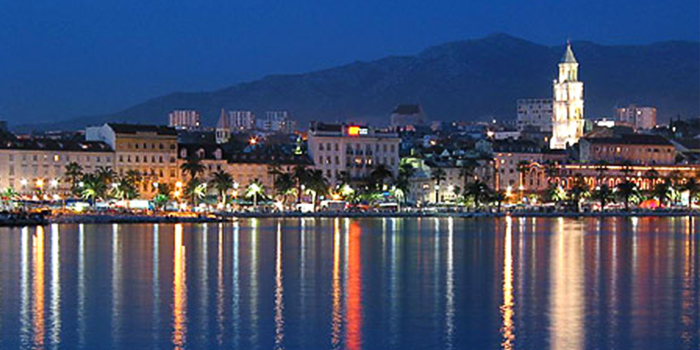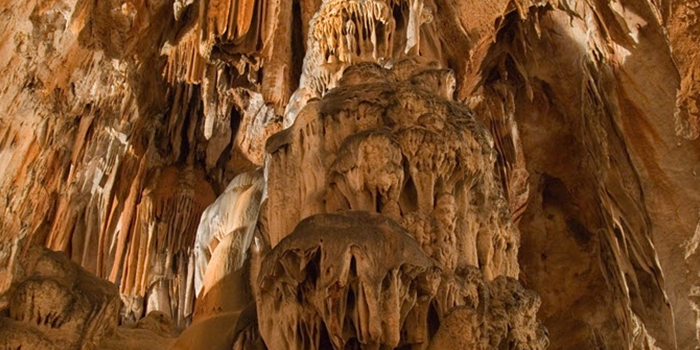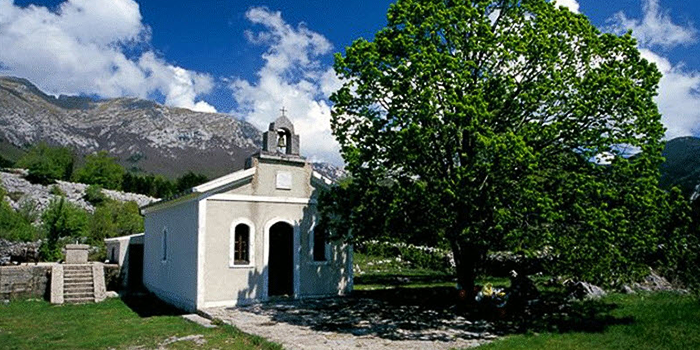Short journey trough history
Short journey trough history

- Educational path
- Mesolithic
- Neolithic and Copper Age
- Bronze Age and Iron Age
- Classical Antiquity
- Middle Ages and Modern Age
Educational Path
 At a first glance, the maritime slope of Velebit range looks like a stone desert, unsuitable for human occupation. This appearance is misleading, however, since the area has been settled some ten thousand years ago, if not earlier. Ancient in ha bi tants have left behind many traces of their presence, their history and prehistory. Our journey through the past has five short chapters. The first three deal with prehistory, from huntergatherers of the final Ice Age, thr ough Neolithic sheph erds, to Liburnian chiefs and the dawn of history. The last two cover the historical period of roman rule and the troubled times of the Middle Ages.
At a first glance, the maritime slope of Velebit range looks like a stone desert, unsuitable for human occupation. This appearance is misleading, however, since the area has been settled some ten thousand years ago, if not earlier. Ancient in ha bi tants have left behind many traces of their presence, their history and prehistory. Our journey through the past has five short chapters. The first three deal with prehistory, from huntergatherers of the final Ice Age, thr ough Neolithic sheph erds, to Liburnian chiefs and the dawn of history. The last two cover the historical period of roman rule and the troubled times of the Middle Ages.
Mesolithic
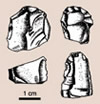 First evidence of people in Velebit During the last Ice Age, this region probably was inhabited by small bands of Paleolithic huntergatherers, just like the rest of the Mediterranean. At that time, the sea level was some 120 meters lower than today. The entire northern Adriatic was dry land, a sprawling grassy plain supporting large herds of wild cattle and horses. Velebit Channel was a wide valley traversed by a river, while Velebit range itself was cold and uninviting, its highest reaches covered by glaciers. Paleolithic huntergatherers kept close to their food sources, mostly located in valleys that were later flooded by the sea. Therefore, it is not surprising that we have not found any trace of them so far. It was only at the end of the Ice Age, when the sea levels began to rise, that the people had to seek out new ways of subsistence in higher, mountainous ground. They still hunted and gathered wild foods, but instead of cattle and horses, which disappeared together with the Adriatic plain, they hunted mountain goats and other animals inhabiting the rugged mountain terrain. The earliest evidence of human presence in the Velebit range, the unremarkable Mesolithic flint artifacts from the deepest layers of Vaganacka Cave near Veliko Rujno, belong to that period.
First evidence of people in Velebit During the last Ice Age, this region probably was inhabited by small bands of Paleolithic huntergatherers, just like the rest of the Mediterranean. At that time, the sea level was some 120 meters lower than today. The entire northern Adriatic was dry land, a sprawling grassy plain supporting large herds of wild cattle and horses. Velebit Channel was a wide valley traversed by a river, while Velebit range itself was cold and uninviting, its highest reaches covered by glaciers. Paleolithic huntergatherers kept close to their food sources, mostly located in valleys that were later flooded by the sea. Therefore, it is not surprising that we have not found any trace of them so far. It was only at the end of the Ice Age, when the sea levels began to rise, that the people had to seek out new ways of subsistence in higher, mountainous ground. They still hunted and gathered wild foods, but instead of cattle and horses, which disappeared together with the Adriatic plain, they hunted mountain goats and other animals inhabiting the rugged mountain terrain. The earliest evidence of human presence in the Velebit range, the unremarkable Mesolithic flint artifacts from the deepest layers of Vaganacka Cave near Veliko Rujno, belong to that period.
Neolithic and Copper Age
 Arrival of the herders Some eight thousand years ago, the earliest farmers entered the Adriatic from the southeast. They arrived by boats, in small groups, bringing wheat, do mesticated sheep and goats, and the basic knowledge of cultivation and herding. Hunting and gathering soon ceased to be im portant and was replaced by farming. Since then, and until quite recently, pastoral life has remained one of the most important economic activities in Velebit. The karstic environment of fers little cultivable soil, but is fairly suitable for raising sheep and goats. Pastures are scattered across the mountain at different altitudes, allowing seasonal use. When grass near the coast dries out in the late spring, herds move up to the still green meadows hidden among the limestone crags. They spend the summer in the highest part of the mountain, on the largest and most abundant pasture grounds. With the coming of autumn rains, as the weather gets colder, the herds descend once again towards the coast. This seasonal movement of herds and shepherds has been going on for thousands of years, since the beginning of the Neolithic. Time and erosion removed all traces of the modest prehistoric shepherd’s huts and sheepfolds, but there are many caves in the karst that also served as shelter for people and their animals. About two dozen such caves are located in the National Park and its immediate neighborhood. Often they are walled off by drystone walls. The largest among them could have accommodated substantial herds of sheep and goats. Archaeological layers that accumulated inside those caves contain informative material remains - numerous bones of domestic animals, as well as discarded tools and accessories of the shepherds. Broken clay pots, variously shaped and decorated, are of particular interest. Pottery styles changed in time and, thanks to that, we can approximately determine the periods during which some of the caves were being used.
Arrival of the herders Some eight thousand years ago, the earliest farmers entered the Adriatic from the southeast. They arrived by boats, in small groups, bringing wheat, do mesticated sheep and goats, and the basic knowledge of cultivation and herding. Hunting and gathering soon ceased to be im portant and was replaced by farming. Since then, and until quite recently, pastoral life has remained one of the most important economic activities in Velebit. The karstic environment of fers little cultivable soil, but is fairly suitable for raising sheep and goats. Pastures are scattered across the mountain at different altitudes, allowing seasonal use. When grass near the coast dries out in the late spring, herds move up to the still green meadows hidden among the limestone crags. They spend the summer in the highest part of the mountain, on the largest and most abundant pasture grounds. With the coming of autumn rains, as the weather gets colder, the herds descend once again towards the coast. This seasonal movement of herds and shepherds has been going on for thousands of years, since the beginning of the Neolithic. Time and erosion removed all traces of the modest prehistoric shepherd’s huts and sheepfolds, but there are many caves in the karst that also served as shelter for people and their animals. About two dozen such caves are located in the National Park and its immediate neighborhood. Often they are walled off by drystone walls. The largest among them could have accommodated substantial herds of sheep and goats. Archaeological layers that accumulated inside those caves contain informative material remains - numerous bones of domestic animals, as well as discarded tools and accessories of the shepherds. Broken clay pots, variously shaped and decorated, are of particular interest. Pottery styles changed in time and, thanks to that, we can approximately determine the periods during which some of the caves were being used.
Bronze Age and Iron Age
 Social hierarchies and monumental structures Communities grew during the Bronze Age, when first monumental structures were erected under the leadership of the emerging elites. Many strategic hilltops and prominent ridges were fortified by enclosing ramparts. Such prehistoric fortifications, usually occupying high ground, are known as hillforts. Hillforts clearly had a defensive purpose. In dangerous times, they could serve as shelter to inhabitants of the surrounding villages. Some of them may have been permanent settlements, seats of power of the local chiefs. Their ramparts, built without mortar of large un dressed stones, today lie in ruins. Resembling large, ring-shaped cairns, their remains can be several meters high. Hillforts overlooking Modric, Seline, Starigrad and Milovac protected the largest tract of arable land in the area. They also controlled the important shepherds’ trails and trade routes that led into Velebit and across the mountain range into Lika. The sea was the most important avenue of travel and trade, especially during the Iron Age, when Liburnian seafarers controlled the northern Adriatic. The probable purpose of a small hillfort on Veliki Vitrenik was navigation control. Located on a prominent peak above the entrance to Velika Paklenica gorge, this hillfort overlooks a large stretch of Velebit Channel. From it, timely warning could have been issued about approaching enemy ships, or return of friends and relatives announced.
Social hierarchies and monumental structures Communities grew during the Bronze Age, when first monumental structures were erected under the leadership of the emerging elites. Many strategic hilltops and prominent ridges were fortified by enclosing ramparts. Such prehistoric fortifications, usually occupying high ground, are known as hillforts. Hillforts clearly had a defensive purpose. In dangerous times, they could serve as shelter to inhabitants of the surrounding villages. Some of them may have been permanent settlements, seats of power of the local chiefs. Their ramparts, built without mortar of large un dressed stones, today lie in ruins. Resembling large, ring-shaped cairns, their remains can be several meters high. Hillforts overlooking Modric, Seline, Starigrad and Milovac protected the largest tract of arable land in the area. They also controlled the important shepherds’ trails and trade routes that led into Velebit and across the mountain range into Lika. The sea was the most important avenue of travel and trade, especially during the Iron Age, when Liburnian seafarers controlled the northern Adriatic. The probable purpose of a small hillfort on Veliki Vitrenik was navigation control. Located on a prominent peak above the entrance to Velika Paklenica gorge, this hillfort overlooks a large stretch of Velebit Channel. From it, timely warning could have been issued about approaching enemy ships, or return of friends and relatives announced.
Most of the hillforts are surrounded by burials of Bronze Age and Iron Age chiefs who held power over the area. They were buried under large, circular stone cairns, in rectangular tombs made of stone slabs. Most of the cairns have been dug up in antiquity and the burials plundered. At the northern edge of Starigrad, in the area called Matkovaca, there are several prehistoric burial cairns.
Classical Antiquity
 Raise and fall of the Roman rule During the last two centuries B.C., Roman legions gradually conquered the eastern Adriatic coast. Lasting Roman authority arrived with the creation of the province of Dalmatia at the beginning of the 1st century A.D. With the Romans came literacy, bringing the area previously controlled by Liburnians into the folds of history. Centuries of “Roman piece” followed, characterized by monetary economy and foundation of the earliest towns. Starigrad, roman Argyruntum, was founded at that time. It was located on a small peninsula, covering an area of only 3,5 hectares. Due to natural and artificial filling, the peninsula is today completely incorporated with the mainland. Argyruntum soon developed into a fairly important market town. The Roman Emperor Tiberius had it fortified by walls and towers in the fourth decade of the 1st century A.D. The town’s cemetery stretched along the road that led from the town towards the southeast. About 400 graves were excavated, yielding rich and variable archaeological finds: jewelry made of silver, bronze and amber, pottery, glass and metal vessels, tools and weapons. They show that the community was relatively affluent and kept lively trade links with many parts of the Mediterranean. Judging by the finds from the cemetery, Argyruntum was abandoned early in the 4th century A.D. Peace was shattered by incursions of the “barbaric peoples” who eventually brought down the once-powerful Roman state. The last attempt to reintegrate the Adriatic coast with the remains of the Empire was made by the Eastern Roman emperor Justinianus. In mid-sixth century A.D., Justinianus built a system of fortifications in order to secure shipping routes and protect the coastal population. Ruined walls and towers above Modric (east of Seline) and Sveta Trojica (near Tribanj) were a part of that defense system, which only briefly postponed the final collapse of the Classical civilization in the Adriatic.
Raise and fall of the Roman rule During the last two centuries B.C., Roman legions gradually conquered the eastern Adriatic coast. Lasting Roman authority arrived with the creation of the province of Dalmatia at the beginning of the 1st century A.D. With the Romans came literacy, bringing the area previously controlled by Liburnians into the folds of history. Centuries of “Roman piece” followed, characterized by monetary economy and foundation of the earliest towns. Starigrad, roman Argyruntum, was founded at that time. It was located on a small peninsula, covering an area of only 3,5 hectares. Due to natural and artificial filling, the peninsula is today completely incorporated with the mainland. Argyruntum soon developed into a fairly important market town. The Roman Emperor Tiberius had it fortified by walls and towers in the fourth decade of the 1st century A.D. The town’s cemetery stretched along the road that led from the town towards the southeast. About 400 graves were excavated, yielding rich and variable archaeological finds: jewelry made of silver, bronze and amber, pottery, glass and metal vessels, tools and weapons. They show that the community was relatively affluent and kept lively trade links with many parts of the Mediterranean. Judging by the finds from the cemetery, Argyruntum was abandoned early in the 4th century A.D. Peace was shattered by incursions of the “barbaric peoples” who eventually brought down the once-powerful Roman state. The last attempt to reintegrate the Adriatic coast with the remains of the Empire was made by the Eastern Roman emperor Justinianus. In mid-sixth century A.D., Justinianus built a system of fortifications in order to secure shipping routes and protect the coastal population. Ruined walls and towers above Modric (east of Seline) and Sveta Trojica (near Tribanj) were a part of that defense system, which only briefly postponed the final collapse of the Classical civilization in the Adriatic.
Middle Ages and Modern Age
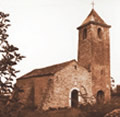 Croats, Turks, Venetians and Bunjevci The Early Middle Ages were marked by turmoil known as “the Great Migrations”. That was the time when Croats arrived to Dalmatia. The earliest preserved evidence of their presence in the neighborhood is the Early Medieval church of St. George in Rovanjska, built in 9th or 10th century A.D. The medieval church of St. Peter shows that Starigrad was again inhabited. The cemetery around the church was used since 13th century, while the most impressive burial monuments - massive stone slabs, sometimes decorated by simple, shallow reliefs - date from the very end of the Middle Ages (14th to 16th century). Two forts were probably built at that time: Vecka Tower, on a cape just east of Starigrad, and Paklaric, on top of a longabandoned prehistoric hillfort, overlooking the entrance to Velika Paklenica gorge. Wars with the Turks that followed lasted for two centuries, devastating the coast and the maritime slope of Velebit. In 1527, Turks occupied Lika and the hinterland of Dalmatia, including the near-by Obrovac on the river Zrmanja. Three decades later they occupied a large part of Ravni Kotari and reached the bay of Novigrad, severing the link between northern and southern parts of Croatia. Velebit’s maritime slope became a “no man’s land”, the scene of action of frequent clashes and raids. Its inhabitants fled and emigrated, leaving the area deserted. Desolation lasted for some 150 years. With the decline of the Turkish might, Venetian authorities began repopulating Starigrad in 1671. By the end of 17th century, almost the entire maritime slope was settled once again. The settlers were Bunjevci, a Croatian population from the neighboring areas that were still under Turkish occupation. When the Turks finally withdrew in year 1700, the area was reunited with the rest of Dalmatia under Venetian rule.
Croats, Turks, Venetians and Bunjevci The Early Middle Ages were marked by turmoil known as “the Great Migrations”. That was the time when Croats arrived to Dalmatia. The earliest preserved evidence of their presence in the neighborhood is the Early Medieval church of St. George in Rovanjska, built in 9th or 10th century A.D. The medieval church of St. Peter shows that Starigrad was again inhabited. The cemetery around the church was used since 13th century, while the most impressive burial monuments - massive stone slabs, sometimes decorated by simple, shallow reliefs - date from the very end of the Middle Ages (14th to 16th century). Two forts were probably built at that time: Vecka Tower, on a cape just east of Starigrad, and Paklaric, on top of a longabandoned prehistoric hillfort, overlooking the entrance to Velika Paklenica gorge. Wars with the Turks that followed lasted for two centuries, devastating the coast and the maritime slope of Velebit. In 1527, Turks occupied Lika and the hinterland of Dalmatia, including the near-by Obrovac on the river Zrmanja. Three decades later they occupied a large part of Ravni Kotari and reached the bay of Novigrad, severing the link between northern and southern parts of Croatia. Velebit’s maritime slope became a “no man’s land”, the scene of action of frequent clashes and raids. Its inhabitants fled and emigrated, leaving the area deserted. Desolation lasted for some 150 years. With the decline of the Turkish might, Venetian authorities began repopulating Starigrad in 1671. By the end of 17th century, almost the entire maritime slope was settled once again. The settlers were Bunjevci, a Croatian population from the neighboring areas that were still under Turkish occupation. When the Turks finally withdrew in year 1700, the area was reunited with the rest of Dalmatia under Venetian rule.
*Taken from www.rivijera-paklenica.hr
One of the many legends about the bora , written in Zoranic " Mountains", the story of a young and beautiful but arrogant girl of noble birth named Bora...
 Which part of Croatia do you find most alluring for a summer holiday?
Which part of Croatia do you find most alluring for a summer holiday?
